Hydrangea is one of the most beautiful and luxurious ornamental plants that can be grown on its plot. In the summer-autumn period, beautiful bright green bushes with spherical large inflorescences are pretending to the views of passersby, and a pleasant aroma is circling his head. The variety of coloring scenery of hydrangea is simply affecting the imagination, among which the varieties with blue flowers particularly distinguish.
Hydrangea of \u200b\u200bblue is not a separate type of culture, but only a group of shrubs combined by coloring inflorescences. Among them you can select hydrangea with one color or several, which change throughout the season. In addition, this plant has one very interesting feature. You can paint the hydrangea in blue and make it brighter.
In this article, consider the peculiarities of growing the varieties of blue hydrangea in its plot, as well as their main characteristics. We note the important moments of landing and care for blue hydrangea.
Features and description of hydrangea blue
Hydrangea is a representative of the genus of flowering plants, which refers to the hydrangea family. This plant group includes approximately 80-100 species, which differ in different peculiarities, as well as sizes and color of inflorescence. The natural habitat is the territory of Eastern and South Asia, namely Japan and China. There are some types of hydrangeas in the Far East in North America. In all these territories, you can find a variety of hydrangea varieties - tree forms, shrubs, lianas, curly plants, leaf fall and evergreen, dwarf and tall forms of hydrangea. The blue hydrangea is most often found at the largest type of this culture, which are famous for the most bright and impressive inflorescences.
The flowering plant hydrangea has several interesting stories of the origin of its name, which cannot accurately describe the appearance and peculiarities of the plant growth. According to one of the legends, the name of this decorative shrub was given in honor of the princess of hydrangea, which was the native sister of the Sacred Roman Empire of Karl Nassau-Siegen. This girl was famous for his beauty, so her name began to identify with this magnificent plant. Plant received its scientific name due to important characteristics of growth - translated from Greek it translates as a "water vessel". This is due to the fact that hydrangea loves to grow on wet areas, and from drying can die.
In our gardens, you can meet the hydrangea garden with blue inflorescences and hydrangea largest blue. Most often, these varieties are famous for their large bright blue flowers. In addition, they can be grown not only in the garden and on the site, but at home.
Description of hydrangea blue:
- Hydrangees with blue flowers are considered to be leafy blooming shrubs for the most part, which belong to the popular variety of large-scale hydrangeas.
- Large hydrangeas are quite cultivated. Initially, they were cultivated as a pot culture, since the first varieties were very gentle and capricious. In the future, breeders brought more frost-resistant varieties that can withstand strong frosts.
- In the nature of the chickens of the hydrangea of \u200b\u200bblue can reach about 1-3 meters, but in the gardening section of the bushes of this plant can grow only 100-150 cm.
- During the entire season, the bushes of varieties of large hydrangea with blue and blue flowers are covered with large and oval leaves with a wavy edge. Sheet plate has a bright green.
- The main decoration of the hydrangea of \u200b\u200bblue is the large spherical inflorescences that are slightly closed from above.
- Inflorescences consist of quite large colors that have several beautiful petals and a base similar to the vessel.
- The kidneys in this type of hydrangea are laid on the shoots of the current year, and the flowers are given the next year. That is why it is so important to carefully monitor the state of shoots throughout the season.
- The group of hydrangea with blue inflorescences can be classified as a variety of heavenly blue flowers, bright blue, as well as with flowers that change 2 or 3 colors for the season.
- Often on the Internet you can find questions how to make Hytenzia blue. Do not be surprised, this plant has a very interesting feature. If pink hydrangea is growing on your site, you can get from non-two-color hydrangea with pink-blue flowers, the color of which changes according to your desire. What can watered hydrangea for blue? For this, fertilizers with an increased sulfur or iron content are suitable, i.e. It is necessary to simply increase the acidity of the soil. This is due to the presence of anthocian plants, which contributes to the change in the color of buds. In the same way, you can strengthen the color of colors with originally blue inflorescences. Many gardeners simply bury the rusty iron objects near the bustard of hydrangea, which will face inflorescences through natural oxidation.
- Many varieties of large hydrangea are not suitable for growing in the middle strip of Russia, but a large number of frost-resistant varieties are brought by breeders that can be decorate. And since the blue hydrangea varieties are most often found among large-scale varieties, then if you wish to grow this chic bush in a temperate climate, give preference to frost-resistant varieties.
Hydrangea varieties with blue flowers
Hydrangea Blue is not a separate type of decorative shrub, but a whole group of various varieties with blue or blue inflorescences. Advantageously, all varieties of blue hydrangeas are large-scale, which is famous for its beauty and splendor. Consider the characteristics of the most popular hydrangea varieties with bright blue inflorescences.
- Hydrangea "Endless Summer". This is the first removable hydrangea that has gained popularity around the world. The shrub can reach 120-150 cm, the plant is also very growing into width - about 100-120 cm. This decorative shrub will delight large and beautiful inflorescences, which in diameter can reach about 10-15 cm. Depending on the soil acidity , This hydrangea variety can have a blue and blue color. Sometimes on one bush, you can watch the colors of two paintings.
- Hortensia Nicko Blue. This is the next grade after the hydrangea "Endless Summer", which is distinguished by long and abundant blossoms. It is an average and fast-growing shrub, which in height can reach 1.5 m. An important feature of this hydrangea variety is that inflorescences appear on the shoots of the current year and the past. Depending on the acidity of soil, inflorescences can be white or skiing blue. Flowers are collected in large, up to 15-30 cm in diameter, spherical inflorescences. If you want to get colors of saturated blue, the shrub can be poured aluminum sulfate so that the pH of the soil is 5.2-5.5.
- MINI PENNY hydrangea. This is a removable hydrangea grade, which is compact bushes. Mini Penny Hydrangea is perfect for growing in containers due to its small size. This decorative shrub forms flowering kidneys on the shoots of this year. Inflorescences have a pink or blue shade depending on the acidity of the soil.
- Hydrangea variety "TVist-N-Shout". The low bustice, which in height can reach 100-120 cm. The plant is formed by reddish shoots with bright green foliage, which on the autumn time becomes a burgundy shade. The color of the inflorescence is changing from pink to blue, depending on the soil. The inflorescence is an openwork core, which is surrounded by large flowers.
- Hydrangea "Blue Wave". This hydrangea variety is derived in Holland. The average grade with thick and rigid stem and beautiful inflorescences that have practically white flowers, which only by the end of the blossom acquire a bluish tint. This variety does not change the color so intensively.
- Hydrangea "BlueBird". Hydrangea Blue Bird is a very popular variety of decorative shrubs, which is perfect for decorating the site. This hydrangea grade is characterized by plenty of inflorescences even on young bushes. Inflorescences are openwork cores surrounded by beautiful sterile colors. The shade of inflorescence can change: on the acidic soil the flowers will be white or light blue, but on alkaline - pink.
- Hortensia Ramars. Very interesting grade of hydrangea, the main feature of which is considered to be a differential. Some plants are completely covered with purple or purple flowers, others are pleased with white-blue or blue inflorescences.
- Grade hydrangea "Freedom". This is a two-color variety. At the very beginning of flowering, the lush bush is covered with pink inflorescences, the core of which becomes blue over time, and the edges are white.
- Hydrangea "Jomari". Beautiful hydrangea grade with large terry flowers of soft blue color. Inflorescences appear on the fees of the second year.
- Grade hydrangea "Compheit". Refers to hybrid varieties. It is a compact average shrub. Inflorescences are large spherical, lilac blue shade with a snow-white core.
- Hydrangea "Hopcorn Blue". Very unusual hydrangea grade, which is distinguished by low growth. On average, the height of such a bustle is 60-80 cm. Inflorescences have an interesting tulip-like shape of blue. Inflorescences are formed on the eve of the second year.
Blue hydrangea reproduction: the most common ways
The blue hydrangea varieties multiply the same as other varieties of this culture. For independent dilution of hydrangea, several ways are suitable: seed reproduction, reproduction of stalling, dividing the bush and grain. Each of the ways has its own characteristics that need to be known to get a beautiful and flowering plant.
Seed reproduction of blue hydrangea
- This method is suitable for breeding species hydrangea. It is used by breeders to remove new varieties. In addition, this is a rather complicated way that takes a lot of time.
- Sowing seeds of hydrangeas blue must be engaged in autumn.
- To do this, prepare the container and fill it with the soil mixture, which should consist of a sheet of land, peat and river sand.
- The soil moisturizes and sow on the surface of the seeds of hydrangea, after which they are covered with a small layer of land.
- The container must be covered with a film or glass to create a greenhouse effect and put on a sunny place, since the temperature of 14-20 degrees is needed to germinate the seeds of hydrangea.
- Regularly need to air crops and moisturize the soil from the spray gun. The soil should always be in a moistened state.
- The first shoots appear about 1-1.5 months, only after that shelter is removed.
- Seizians need to dive twice. The first time it is done when a couple of leaves appears, and the second time already in May.
- In May, young seedlings planted into separate pots and periodically exhibit on fresh air for hardening.
- At home, hydrangea seedlings are grown for two years, after which the pasta seedlings can be planted at a permanent place.
Gorishtenization breeding with blue stalling
- This method of reproduction of hydrangea is considered the most popular, moreover, this is a fairly simple option.
- It is necessary to harvest the cuttings from April to June, while the planting material should be 10-15 cm and it is necessary to cut it from young shoots, or rather from their tops.
- The slice must be at a right angle.
- For rooting, it is necessary to prepare special containers with soil mixture or you can land cuttings into the greenhouses.
- The soil mixture should consist of river sand and peat, where it is recommended to add a little moss to increase moisture.
- Before landing, the cuttings must be treated with growth stimulants.
- The cuttings are roasted at a low angle at a distance of about 5 cm between them.
- For complete rooting, approximately 4-5 weeks. During this time, young plants acquire pretty strong and developed roots.
- In the first year after landing, the seedlings need to be covered and cutting the inflorescences.
- You can deal with winter stalling, but it is only suitable for large hydrangea, to which most varieties of blue hydrangea belongs.
- The cuttings can be harvested in February, and for this you need an adult plant to transplant to the container and transfer to the house. And then the caused shoots to cut into the cuttings.
- There should be 2 knots on the cuttings, the lower leaves are completely cut off, and the upper removed partially.
- Before rooting, the cuttings are treated with growth stimulant.
Blue hydrangea reproduction by grain
- The reproduction of hydrangea with blue decodes is carried out in spring.
- To do this, it is necessary on an adult shrub, lateral shoots are selected, and the furrows are prepared under them, the depth of which should be approximately 15-20 cm.
- In these furrows, shoot shoots and fix them with brackets.
- After that, you can make small cuts on the part of the escape that comes into contact with the soil.
- The central part of the escape is covered with soil.
- Further care is regular watering.
- The chains are rooted in about the next spring or autumn, when the young plant can be disconnected from the mother's bush and transplant to a permanent place.
Preparation before planting hydrangea blue
Hydrangea of \u200b\u200ball varieties, including blue inflorescences, do not differ in a capricious character, but for their full growth, some of the features and rules should be clearly observed. First of all, it is important to spend thorough preparatory work, including the acquire a high-quality seedling and find an ideal place for landing on its plot.
Stage 1. Selection of varieties and hydrangea seedlings blue
- First of all, it is necessary to decide with the variety of hydrangea blue, which you want to grow in your site. For the middle strip of Russia, you need to select modern frost-resistant hydrangea varieties with blue inflorescences. You can pay your attention to such varieties like "Bluebird", "Early Sensation", "Endless Summer" and others.
- Create hydrangeans of hydrangea of \u200b\u200bblue are needed in specialized garden centers and nurseries who are engaged in professional breeding plants. Only buying the planting material in such a place will bring you the desired result.
- You can buy blue hydrangea seedlings with both an open root system and closed. It is only necessary to remember that young plants in the container can be planted at any time, and with open roots you need to plant in the shortest time.
- Before buying, be sure to carefully check the condition of the planting material. The shoots of the plant should be strong, young growing branches should also be visible.
- If you buy a seedling with an open root system, pay attention to the roots' condition. They must be elastic and soft. So they can remain within some time.
Stage 2. Choosing a place for landing hydrangea blue
- For a full growth of hydrangea, it is important to choose the right place to land.
- It is important to remember that this plant prefers to grow in a small half, which allows hydrangea to reveal all the beauty of their leaves and inflorescences.
- It is not worth landing in the sizes of hydrangea of \u200b\u200bblue colors on an open sunny side, as inflorescences can become smaller.
- For this plant fits a moisture place.
- If you decide to plant a few hortensia nearby, do not forget to leave the necessary space for each plant, which should be about 2 m for cookies.
Stage 3. Choice and soil preparation for landing blue hydrangea
- The most important thing is to competently choose the ground for landing hydrangea. From this direct will depend on the state of the plant and the color of its inflorescences.
- Hydrangea of \u200b\u200bblue varieties prefers to grow on well-moistened drained soils. Ideal if the soil moisturizing is natural.
- Soil should not contain lime even in small quantities - this may affect the full development of the plant.
- For hydrangea with blue or blue inflorescences, the soil must be with pH 5-5.5. It will contribute to a brighter and rich coloring of colors. Next to the bush, you can burst a little rusty iron, it will strengthen the colors.
- Before landing, it is important to carefully prepare a plot. To do this, carefully disappear the selected place, shuffle the soil and scatter it. This can be done in a couple of weeks before landing.
Technology landing hydrangea blue
- In the open ground, the hydrangea is planted in spring or autumn. For the middle strip of Russia, it is recommended to do a spring landing so that young plants can graze before the onset of cold.
- On the prepared area it is necessary to dig up the landing pit. It is best to do it in one day before landing. The landing pit should be about two times the size of the root system with the ground. You can focus on the parameters of 50 cm deep and 50 cm in width.
- Also in landing pits you need to pour about 3-5 water buckets.
- Prepare the soil mixture, which should consist of a sheet of land, upper peat, compost from sawdust, which can be collected under fir trees and pines, as well as river sand for drainage.
- The substrate also needs to add mineral fertilizers and the organic.
- In the prepared landing pits, you need to pour a small slide of the soil mixture and put on it seedlings of hydrangea of \u200b\u200bblue.
- After that, we carefully fall asleep the holes with the soil and the hands sealing it around the plants. In this case, consider that the root neck must be at the same level with the soil.
- The rolling trunk around the plants should be meditated. To do this, use a mixture of bark of trees and sawdust.
- Be sure to hide the planted seedlings.
Agrotechnology of Growing Hydrangea Blue: Secrets and Nuances of Care
- Watering. Hydrangea is a moisture-loving plant that does not endure even the slightest drought. Therefore, it is important to strictly observe the watering mode. It is necessary to water each plant approximately 2 times a week, while one plant should leave 30-50 liters of warm and outstanding water.
- Loosening and mulching. Periodically, the soil around the plant is important to loosen well, ensuring this oxygen access to the roots of the plant. However, it is worth being very attentive when loosening, because the root hydrangea system is superficial. The permissible depth of loosening is 5 cm. At the very beginning of the summer, it is worth closing the rolling circle that will protect roots from overheating and drying.
- Feeding For full growth in hydrangea, it is important to carry out regular feeding. At least twice a year, plants are fed by complex mineral fertilizers - before flowering and after. To do this, you can use urea. During flowering, you can use a dung alive, but not often not to reconcile the plant.
- Changing the color of hydrangea. If pink hydrangea is growing on your site, and you want to get blue, you can try to repaint your colors. For this, aluminum sulfate is used, approximately 1 tbsp. Aluminum on 5 liters of water. Such a composition can water the plant every 2 weeks.
- Trimming. First of all, in the first year after landing, all the colors on the plant must be cut off. Pruning is carried out in spring to swelling. Before in winter, shoots are cut up to 4 kidneys, and if you need to upgrade the old bush, cut down the shoots under the root. The forming trim is needed to get a beautiful busta.
- Hydrangea wintering. If you planted the blue hydrangea of \u200b\u200bfrost-resistant varieties in the first years, it is still worth covering the plant for the winter. For this, all shoots must be carefully hugged to the ground and hide them with a sweetheart, sawdust and fading grass. If a large number of snow falls in winter, it is recommended to clean it, as its weight can break the shoots.
Photo of hydrangea blue
Hydrangea is a very bright and spectacular plant that will become an excellent decoration of your garden. Especially highlights varieties with blue painting inflorescences, whose brightness can be changed at will. It is not difficult to grow such a miracle on its plot, the main thing is to pay attention to the plant and take care of him.

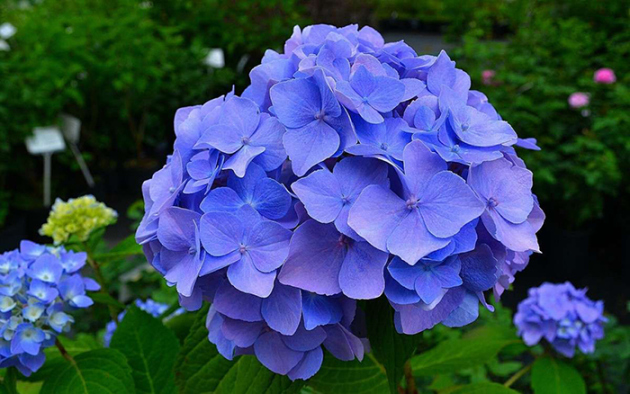
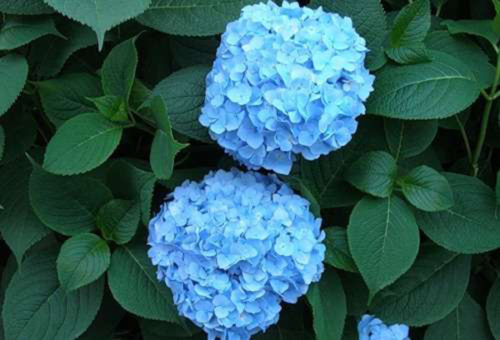
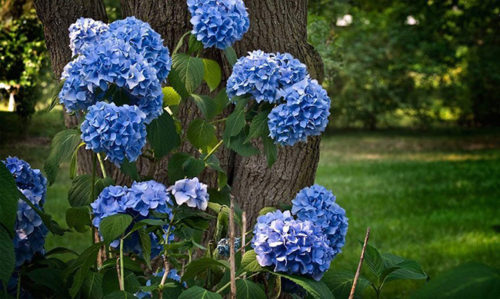
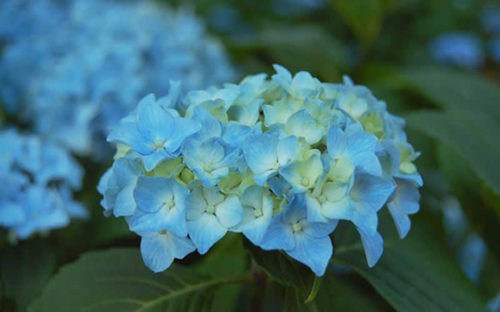

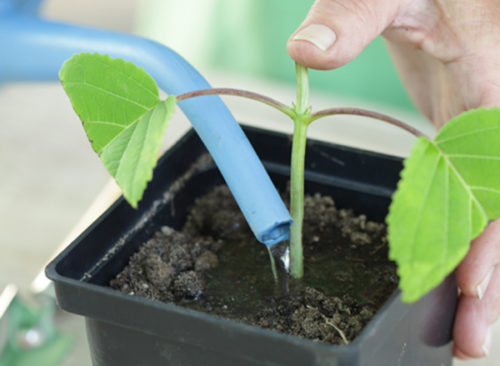
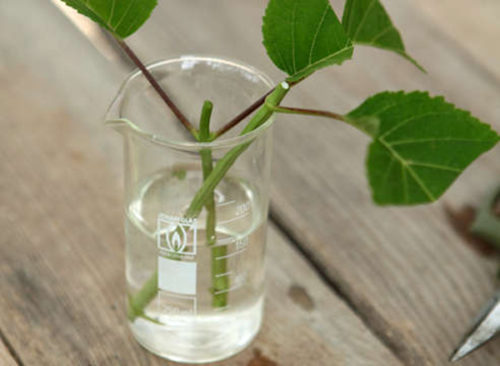
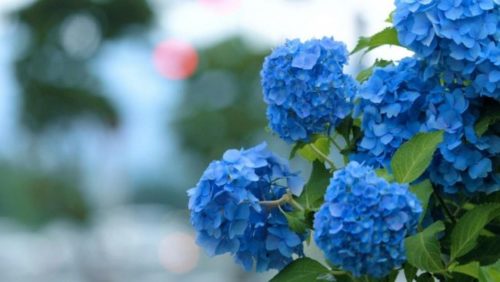
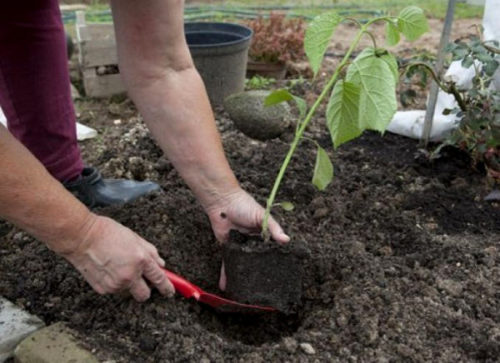
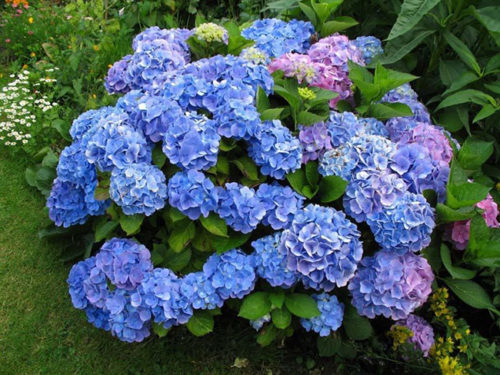

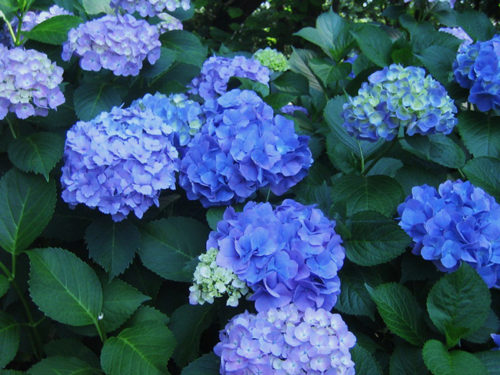
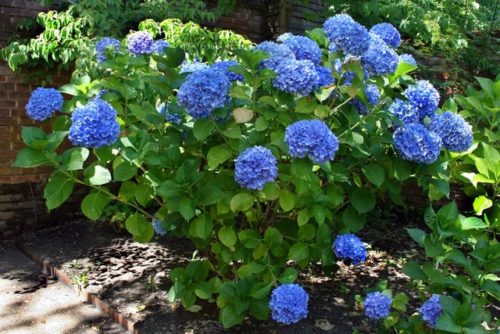
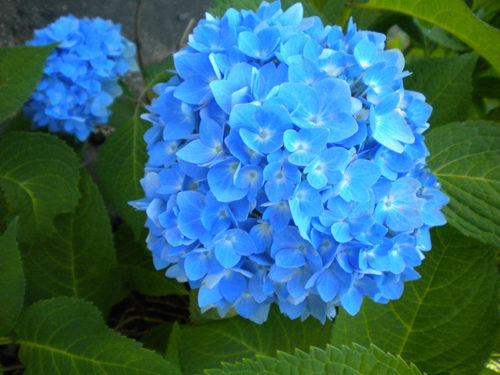
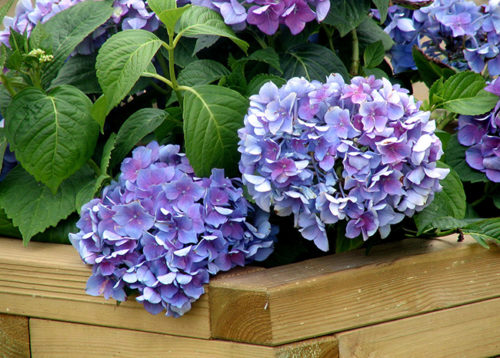
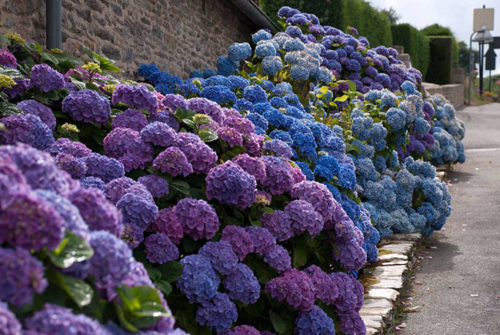












 Start a discussion ...
Start a discussion ...